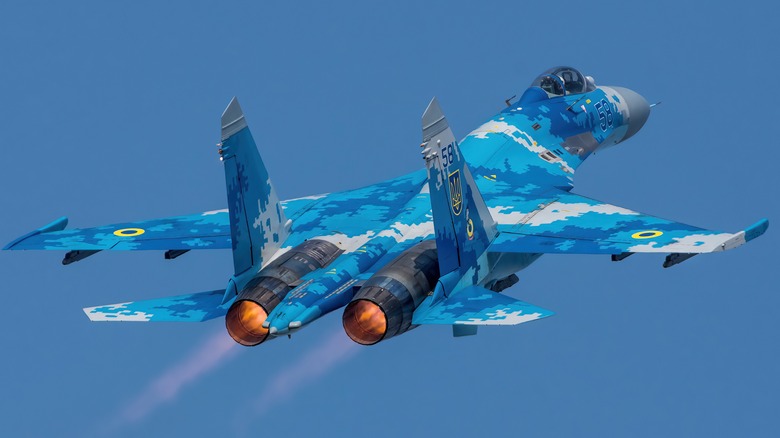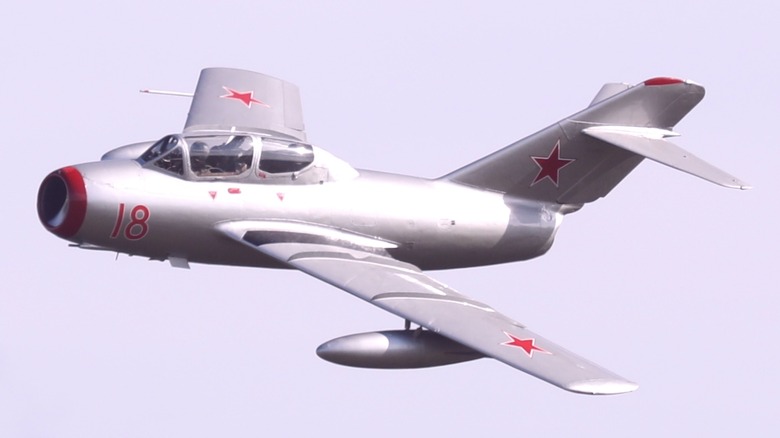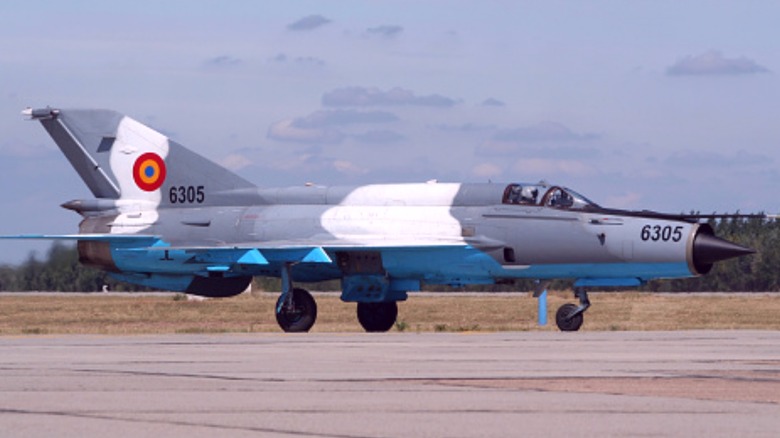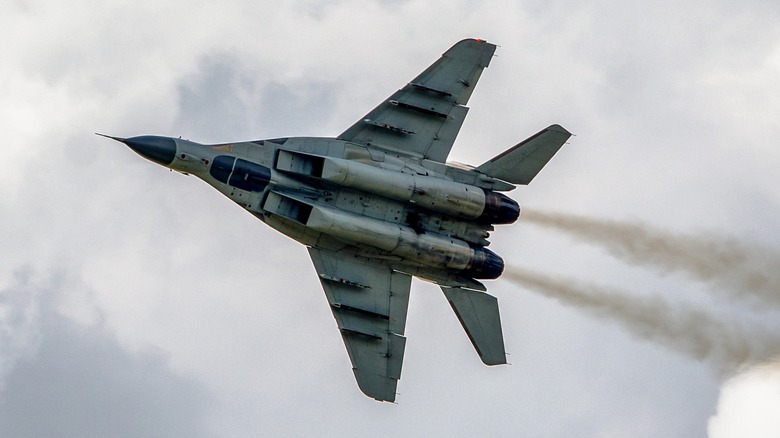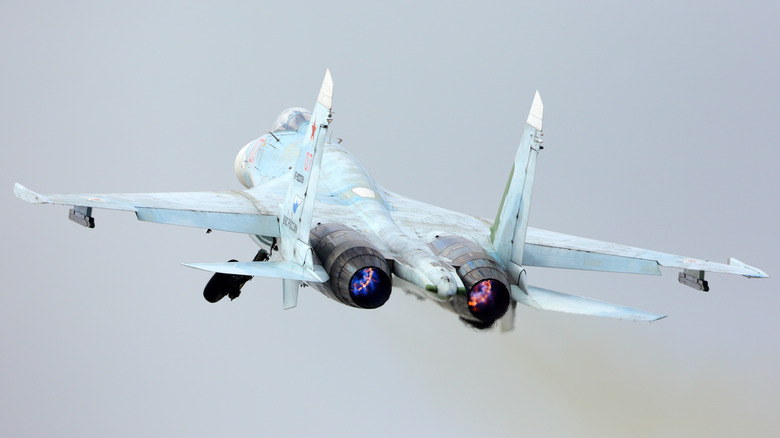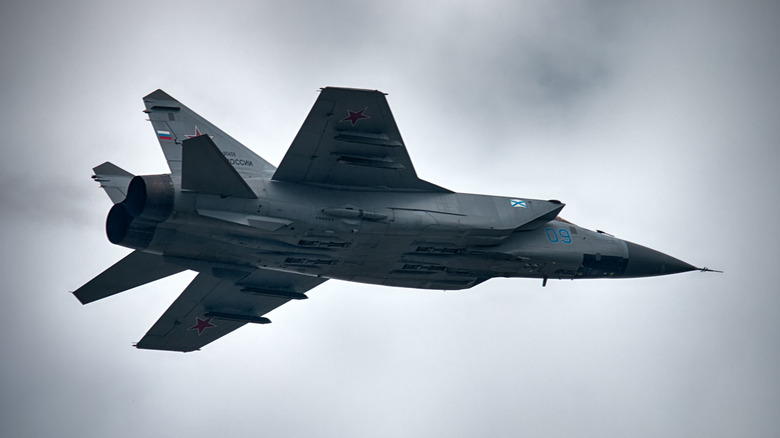5 Soviet Fighter Jets The US Feared During The Cold War
The Cold War was an unusual time to be alive, with children practicing duck and cover drills in school and apprehension of nuclear weapons. Throughout the 45 years of the Cold War, the United States and the Union of Soviet Socialist Republics one-upped each other in developing various military and scientific technologies. While the Space Race is probably the best-known example of this, U.S. and U.S.S.R. competition went all the way down to small arms and bullet design.
There's a lot of technology between bullets and ICBMs, and one area in which both nations excelled was the development of fighter jets. Throughout the Cold War, the U.S. developed the F-14 Tomcat, F-15 Eagle, F/A-18 Hornet, AV-8B Harrier, and much more. Of course, the Soviets didn't sit by and watch the States develop faster and more efficient flying killing machines; they built plenty of their own, and many posed significant threats to American interests worldwide.
Soviet technology developed exponentially, helping the nation build fighter jets that, thanks to arms sales, dominated the skies of Europe and elsewhere throughout the world. You can find many Cold War-era Soviet aircraft in nations all over the planet, and there are several reasons for their ubiquity, including a relatively low cost, ease of upkeep, and versatility of numerous Cold War Soviet fighter jets, many of which sent shivers down American pilots' spines throughout the conflict.
MiG-15
The MiG-15 is one of the oldest and most successful aircraft produced by the Soviet Union during the Cold War. The MiG-15 introduced swept wings for the first time for the Soviets, enabling the MiG-15bis variation to achieve high transonic speeds of 611 mph. The fighter first flew in 1947, and by 1950, they'd engaged U.S. pilots operating F-80C Shooting Stars and B-29 Superfortresses during the Korean War.
That conflict saw numerous dogfights carried out by MiG-15s in an area near the Yalu River border known as "MiG Alley." While many pilots were North Koreans, the Americans and other UN participant nations engaged Soviet pilots, though Soviet involvement was a poorly kept secret. Regardless, the MiG-15 performed remarkably well, demonstrating its superior maneuverability over the U.S. fighters used early in the war.
The MiG-15 was a remarkable aircraft, but Soviet Premier Joseph Stalin wanted to ensure his pilots avoided capture, so he limited their engagement. This left North Korean pilots to take on the brunt of the fighting, and they weren't as combat-effective as their Soviet comrades. As a result, while the MiG-15 did its fair share of damage throughout the Korean War and in "MiG Alley," it was ultimately proven inferior to the American F-86 Sabre, which ultimately maintained a kill ratio of around 8:1 against the MiGs.
[Featured image by wallycacsabre via Wikimedia Commons | Cropped and scaled | CC BY 2.0 DEED]
MiG-21 Fishbed
The MiG-21 Fishbed entered active service in 1960, replacing the older MiG-17 and MiG-19s. The MiG-21 was faster and capable of achieving Mach 2.05 (1,572 mph); it included swept-back wings, a nose intake, and a more streamlined design over legacy models. The MiG-21's speed made it a successful aircraft in combat, and it saw the most use during the Vietnam War, where it most commonly faced American F-4 Phantoms, where it employed its AA-2 ATOLL infrared homing air-to-air missiles to devastating effect.
The Soviet Union provided the Vietnam People's Air Force (VPAF) with MiG-21s, which were quickly put to use, fighting against the Americans and South Vietnamese. In many engagements, the MiG-21 proved its worth, and by the end of the conflict, 13 North Vietnamese pilots earned their aces, having shot down at least five enemy aircraft during combat. Other pilots aced while flying the MiG-17, but the newer model scored more victories.
While the MiG-21 proved successful in Vietnam, the aircraft doesn't have the best reputation. It's known colloquially as the "Flying Coffin" due to its penchant for dropping out of the sky. This remains a problem, as the aircraft continues flying to this day. In July 2022, the Indian Air Force lost two pilots using MiG-21s for training. Despite these problems, the MiG-21 remained a deadly and capable aircraft throughout the Cold War.
MiG-29 Fulcrum
Soon after the United States developed the F-16 Fighting Falcon and F/A-18 Hornet, the designers at the Mikoyan design bureau developed the MiG-29 Fulcrum to counter the threat. The MiG-29 is an air superiority fighter boasting many of the same advances as its Western counterpart. The aircraft's design enables functioning as a multirole fighter, so its use wasn't limited to interception or bombing — it's capable of air-to-air and air-to-surface engagements and can carry a variety of munitions.
The MiG-29 tops out at Mach 2.25 (1,726 mph), but its speed is only one factor of its lethality. The aircraft's dogfighting capabilities made it a dangerous fighter throughout its time during the Cold War. One aspect of the MiG-29 that made it deadlier than its predecessors was the inclusion of the Shchel-3UM-1 helmet-mounted aiming device. This made it possible for pilots to look at a target to achieve a lock. Previously, Soviet aircraft had to turn to face a threat or target before a missile's sensors could identify it.
The MiG-29 continues flying for various nations, many of which were formerly within the Soviet Union. Ukraine and Russia used MiG-29s during the 2022 Russian invasion of Ukraine, though their record has been spotty. Numerous aircraft have been shot down or destroyed on the ground by both sides of the fight, as each side employed them for air superiority missions against the other. According to Oryx, 25 MiG-29s were destroyed during the initial invasion.
Su-27 Flanker
The Soviet Union introduced the Su-27 Flanker in 1985 to counter U.S. fourth-generation fighters like the F-15 Eagle. The aircraft's design somewhat mirrors its Western rivals, and its use included all aerial warfare operations, as it's a multirole fighter, though initially designed for air superiority. The Su-27 came in a variety of variations for different roles, including the Su-30, 33, 34, 35, 37, and Su-37. The Su-27 could reach speeds of Mach 2.35 (1,803 mph) and operate at a range of 1,620 miles.
The aircraft bears a striking resemblance to the F-15, which isn't an accident, as its designers at Sukhoi had that aircraft in mind. The aircraft can carry up to eight air-to-air missiles or a variety of bombs and other types of missiles. Because the aircraft resembled the F-15 and matched many of its capabilities, the Su-27 posed a threat to the West. Fortunately, it never got the chance to engage Western targets during the Cold War.
The Soviet Union's breakup resulted in Su-27 sales to numerous countries. China produces its own variant, the Shenyang J-11, under license from Russia, and other nations continue operating Su-27s for a variety of roles. While the Su-27 is an air superiority aircraft, its limited combat engagements haven't afforded it an opportunity to fill that role. They've flown for both sides during the Russia-Ukraine war, where several Ukrainian Su-27s were lost in air-to-air combat.
MiG-25 Foxbat
The MiG-25 Foxbat is one of the fastest fighters developed throughout the Cold War. The aircraft could reach speeds of Mach 2.83 (2,171 mph) and was of considerable concern to the West. The aircraft remained an enigma for years after its introduction in 1970, with much of the concern centering around its incredible speed. The MiG-25's observed prototypes could climb to 98,425 feet in four minutes and could reach an altitude ceiling of 123,520 feet, making it somewhat comparable to the SR-71 Blackbird.
This frightened people in the West, and while the MiG-25 was a superior aircraft, it took a defection to assuage most people's fears. In 1976, a Soviet pilot named Viktor Belenko defected from the U.S.S.R. and landed his MiG-25 in Japan. At the time, George H.W. Bush was working as the Director of Central Intelligence, and he declared the defection an opportunity that presented an "intelligence bonanza" related to the aircraft's capabilities, according to Time.
After examining the aircraft, engineers in the West understood its capabilities beyond earlier predictions. While the MiG-25 proved itself a capable fighter, Belenko arrived without any missiles, which was what the West wanted to examine. Ultimately, the defection provided some but not all information about the MiG-25. Still, it remains the second-fastest manned serially produced aircraft after the SR-71, so it was a significant feat of aerospace engineering.
